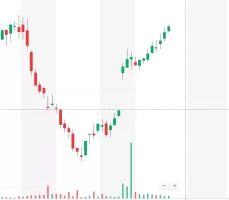Andreas Thiel
Regular Contributor
FASTLANE INSIDER
LEGACY MEMBER
MEMBER
Read Rat-Race Escape!
Read Fastlane!
Read Unscripted!
Hi guys,
does anybody have experience with a trading strategy that revolves around limiting the downside while benefiting from outliers to the upside?
The big picture idea is that if you place 52 bets per year (roughly one per week) and if you get close to a 50% chance of succeeding then the exponential nature of the approach could be appealing.
Examples:
Say you limit the downside by placing a stop-loss limit 20% under the level you buy at ...
you increase that limit to the level you bought at if the position rises 10% ...
you increase the limit to 20% gains when the position rises 30%, to 40% when the position rises to 50% etc. ...
Then having 26 winning bets at an average (after subtracting losses of losing bets) of
The issues that I see with this approach are
Does anybody know how much the odds can be tweaked by analysing the charts?
Anything else that makes such an approach problematic?
does anybody have experience with a trading strategy that revolves around limiting the downside while benefiting from outliers to the upside?
The big picture idea is that if you place 52 bets per year (roughly one per week) and if you get close to a 50% chance of succeeding then the exponential nature of the approach could be appealing.
Examples:
Say you limit the downside by placing a stop-loss limit 20% under the level you buy at ...
you increase that limit to the level you bought at if the position rises 10% ...
you increase the limit to 20% gains when the position rises 30%, to 40% when the position rises to 50% etc. ...
Then having 26 winning bets at an average (after subtracting losses of losing bets) of
- 5% would triple your money (1.05^26)
- 10% would more than 10x your money (1.1^26)
- 20% would more than 100x your money (1.2^26)
The issues that I see with this approach are
- you would have to go for Knock-Out certificates with strong leverage - so 20% downswings would probably exceed the 50% probability
- 30%+ moves to the upside over the course of one week would have to be pretty common, so phases of low volatility would be problematic
- To break even after a 20% loss you need a gain of 25% ... so an average of 30% gains would be required for 5% of actual gains
- Big pre-markets moves can lead to losses significantly greater than the stop-loss barrier
Does anybody know how much the odds can be tweaked by analysing the charts?
Anything else that makes such an approach problematic?
Dislike ads? Become a Fastlane member:
Subscribe today and surround yourself with winners and millionaire mentors, not those broke friends who only want to drink beer and play video games. :-)
Last edited:
Membership Required: Upgrade to Expose Nearly 1,000,000 Posts
Ready to Unleash the Millionaire Entrepreneur in You?
Become a member of the Fastlane Forum, the private community founded by best-selling author and multi-millionaire entrepreneur MJ DeMarco. Since 2007, MJ DeMarco has poured his heart and soul into the Fastlane Forum, helping entrepreneurs reclaim their time, win their financial freedom, and live their best life.
With more than 40,000 posts packed with insights, strategies, and advice, you’re not just a member—you’re stepping into MJ’s inner-circle, a place where you’ll never be left alone.
Become a member and gain immediate access to...
- Active Community: Ever join a community only to find it DEAD? Not at Fastlane! As you can see from our home page, life-changing content is posted dozens of times daily.
- Exclusive Insights: Direct access to MJ DeMarco’s daily contributions and wisdom.
- Powerful Networking Opportunities: Connect with a diverse group of successful entrepreneurs who can offer mentorship, collaboration, and opportunities.
- Proven Strategies: Learn from the best in the business, with actionable advice and strategies that can accelerate your success.
"You are the average of the five people you surround yourself with the most..."
Who are you surrounding yourself with? Surround yourself with millionaire success. Join Fastlane today!
Join Today


